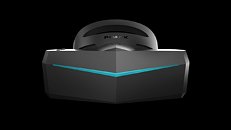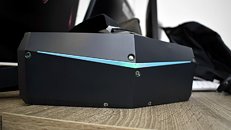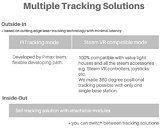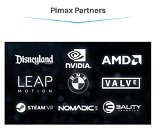Raevenlord
News Editor
- Joined
- Aug 12, 2016
- Messages
- 3,755 (1.18/day)
- Location
- Portugal
| System Name | The Ryzening |
|---|---|
| Processor | AMD Ryzen 9 5900X |
| Motherboard | MSI X570 MAG TOMAHAWK |
| Cooling | Lian Li Galahad 360mm AIO |
| Memory | 32 GB G.Skill Trident Z F4-3733 (4x 8 GB) |
| Video Card(s) | Gigabyte RTX 3070 Ti |
| Storage | Boot: Transcend MTE220S 2TB, Kintson A2000 1TB, Seagate Firewolf Pro 14 TB |
| Display(s) | Acer Nitro VG270UP (1440p 144 Hz IPS) |
| Case | Lian Li O11DX Dynamic White |
| Audio Device(s) | iFi Audio Zen DAC |
| Power Supply | Seasonic Focus+ 750 W |
| Mouse | Cooler Master Masterkeys Lite L |
| Keyboard | Cooler Master Masterkeys Lite L |
| Software | Windows 10 x64 |
Pimax is a little-known company based of Shangai and Silicon valley, but it's looking to disrupt the VR HMD Market with its Pimax 8K headset. Let's get this straight right off the bat - we aren't in the presence of a real 8K panel on the Pimax. Instead, each eye is offered a low-persistence, 4K panel angled at 45º - which is more than enough, by anecdotal, subjective evidence, to rid this headset from the dreaded "screen door" effect. Due to the panels' resolution and their angling, Pimax is promising a 200º FOV, which apparently makes it so that your peripheral vision now fully works as if your were headset-less - and is around double the FOV of other headsets such as the Oculus Rift and HTC Vive.
There will be three different models in the next generation of Pimax HMDs (the company has already delivered a product in the form of the Pimax 4K HMD, and sold 30,000 units of that headset, if you're wondering). The Pimax 5K, Pimax 8K, and the Pimax 8K X have all the same features and functionality save for their display and input resolutions. The Pimax 5K has a pair of 2560x1440 panels, and comes cheapest $399 - it's comparable to the Oculus Rift at that price-point. The Pimax 8K has the full-resolution 3840x2160 per-eye displays running at the full 90 Hz refresh rate, but it relies on pixel-doubling to make driving the system easier. Finally, the Pimax 8K X is fundamentally the same headset as the 8K, and its $699 Kickstater price offers (or offered) improved signal processing hardware to allow it to take a full-resolution dual-4K input signal.





The pixel-doubling capabilities of the Pimnax 8K are very interesting, in that subjective accounts point to no discernible difference to the full 2x 4K rendering resolution needed to drive the 8K X, but basically halves the processing requirements of your graphics card. It could be a much better solution for users that want to have a full VR experience without the dreaded screen-door effect, but not have to purchase one (or even two, more likely...) top tier graphics cards just to drive the headset with settings that make it worth it.




The Pimax 8K HMDs will come in lighter than already existing solutions in the market, due to the usage of plastic in its construction. I know; it's plastic. However, headset weight is being touted as one of the primary factors for comfortable VR journeying, so that's always a positive. And on another note, the Pimax HMDs will feature a USB Type-C accessory port that makes them compatible with some interesting add-ons, such as Leap Motion's gesture controllers, or even a scent station, that (you guessed it) produces scents based on the action that's being delivered to the HMD.
Pimax's headsets will be 100% compatible with Valve's SteamVR "lighthouse" trackers. They also are compatible with all SteamVR and Viveport software, and Pimax says that owners can make use of Oculus' Home software through a third-party utility.The company also has plans to offer its own "PiPlay" content delivery platform, as well as its own hand-held motion controllers with SteamVR support. The company has decided to bring their development resources towards a Knuckles-like controller instead of the wand designs more commonly used by this generation of VR sets, which should make the system even more competitive and interesting to use.
What do you think? Is this the VR HMD that might actually have the hardware to spark a VR revolution? If so, you can check out the company's KickStarter page that's listed on the sources, though almost all of the early bird first picks have already been cleaned out.



View at TechPowerUp Main Site
There will be three different models in the next generation of Pimax HMDs (the company has already delivered a product in the form of the Pimax 4K HMD, and sold 30,000 units of that headset, if you're wondering). The Pimax 5K, Pimax 8K, and the Pimax 8K X have all the same features and functionality save for their display and input resolutions. The Pimax 5K has a pair of 2560x1440 panels, and comes cheapest $399 - it's comparable to the Oculus Rift at that price-point. The Pimax 8K has the full-resolution 3840x2160 per-eye displays running at the full 90 Hz refresh rate, but it relies on pixel-doubling to make driving the system easier. Finally, the Pimax 8K X is fundamentally the same headset as the 8K, and its $699 Kickstater price offers (or offered) improved signal processing hardware to allow it to take a full-resolution dual-4K input signal.





The pixel-doubling capabilities of the Pimnax 8K are very interesting, in that subjective accounts point to no discernible difference to the full 2x 4K rendering resolution needed to drive the 8K X, but basically halves the processing requirements of your graphics card. It could be a much better solution for users that want to have a full VR experience without the dreaded screen-door effect, but not have to purchase one (or even two, more likely...) top tier graphics cards just to drive the headset with settings that make it worth it.




The Pimax 8K HMDs will come in lighter than already existing solutions in the market, due to the usage of plastic in its construction. I know; it's plastic. However, headset weight is being touted as one of the primary factors for comfortable VR journeying, so that's always a positive. And on another note, the Pimax HMDs will feature a USB Type-C accessory port that makes them compatible with some interesting add-ons, such as Leap Motion's gesture controllers, or even a scent station, that (you guessed it) produces scents based on the action that's being delivered to the HMD.
Pimax's headsets will be 100% compatible with Valve's SteamVR "lighthouse" trackers. They also are compatible with all SteamVR and Viveport software, and Pimax says that owners can make use of Oculus' Home software through a third-party utility.The company also has plans to offer its own "PiPlay" content delivery platform, as well as its own hand-held motion controllers with SteamVR support. The company has decided to bring their development resources towards a Knuckles-like controller instead of the wand designs more commonly used by this generation of VR sets, which should make the system even more competitive and interesting to use.
What do you think? Is this the VR HMD that might actually have the hardware to spark a VR revolution? If so, you can check out the company's KickStarter page that's listed on the sources, though almost all of the early bird first picks have already been cleaned out.



View at TechPowerUp Main Site




